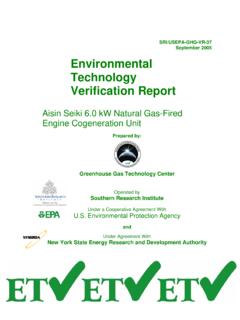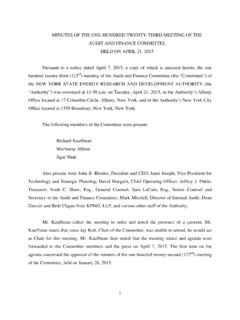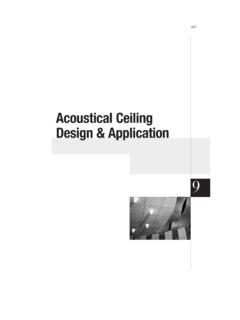Transcription of Sustainable Prepared by: Transportation Strategies
1 Prepared by: Sustainable Transportation Strategies July 2012 i This material is based upon work supported by the Department of Energy under Award Number #DE-EE0005586. NOTICE This report was Prepared as an account of work sponsored by an agency of the United States Government. Neither the United States Government nor any agency thereof, nor any of their employees, makes any warranty, express or implied, or assumes any legal liability or responsibility for the accuracy, completeness, or usefulness of any information, apparatus, product, or process disclosed, or represents that its use would not infringe privately owned rights. Reference herein to any specific commercial product, process, or service by trade name, trademark, manufacturer, or otherwise does not necessarily constitute or imply its endorsement, recommendation, or favoring by the United States Government or any agency thereof. The views and opinions of authors expressed herein do not necessarily state or reflect those of the United States Government or any agency thereof.
2 This report was Prepared by Sustainable Transportation Strategies in the course of performing work contracted for and sponsored by the New York State Energy Research and Development Authority (hereafter NYSERDA). The opinions expressed in this report do not necessarily reflect those of NYSERDA or the State of New York, and reference to any specific product, service, process, or method does not constitute an implied or expressed recommendation or endorsement of it. Further, NYSERDA, the State of New York, and the contractor make no warranties or representations, expressed or implied, as to the fitness for particular purpose or merchantability of any product, apparatus, or service, or the usefulness, completeness, or accuracy of any processes, methods, or other information contained, described, disclosed, or referred to in this report. NYSERDA, the State of New York, and the contractor make no representation that the use of any product, apparatus, process, method, or other information will not infringe privately owned rights and will assume no liability for any loss, injury, or damage resulting from, or occurring in connection with, the use of information contained, described, disclosed, or referred to in this report.
3 1 Sustainable Transportation Strategies SITE DESIGN FOR ELECTRIC VEHICLE CHARGING STATIONS VERSION JULY 20 12 Prepared by: Sustainable Transportation Strategies Author: David Mayfield Editor: Carlotta Collette This report was made possible through the support of New York State Energy Research and Development Authority As well as continued support by: Clean Fuels Ohio Virginia Clean Cities Thanks to the Transportation and Climate Initiative and all 16 of its Clean Cities Coalition partners for providing best practices from the Northeast for this report. Thanks also to the numerous individuals who improved the quality of this document through peer review. 2 Sustainable Transportation Strategies Now that communities are ramping up with installations of EV supply equipment, designers are encountering a host of design issues that are generating creative solutions and mistakes. 1 INTRODUCTION Sustainable Transportation Strategies Prepared this report to highlight best practices for designing electric vehicle (EV) charging stations those parking spaces where EV supply equipment will be used to charge vehicles.
4 Now that communities are ramping up with installations of EV supply equipment, designers are encountering a host of design issues that are generating creative solutions and mistakes. This report is intended to be used by persons who are responsible for safe and convenient design of EV charging stations. Many topics covered by this report are beyond the professional responsibility of electrical contractors. The report should be used alongside other resources, including those that cover electrical design standards for installation of EV supply equipment. Site Design for Electric Vehicle Charging Stations addresses the kind of equipment available and how parking facility design offers both opportunities and challenges for charging station installations. Several design scenarios are illustrated. 2 WHAT KIND OF EV SUPP LY EQUIPMENT IS AVAILABLE? In the near term, EVs will use the following three categories of EV supply equipment classified according to power levels and circuit requirements: AC Level 1, up to 120-volt single-phase circuit with either 15-ampere (amp) or 20-amp configuration.
5 AC Level 2, 208-volt to 240-volt single-phase circuit with an 80-amp maximum, but often using 40-amp rated circuits. DC fast charger, converts AC power levels rated at 208 volts to 480 volts (3-phase) to DC power to deliver up to 50 kilowatts at the EV s battery voltage. 3 Sustainable Transportation Strategies Level 1 EV supply equipment Level 2 EV supply equipment DC fast charger Both Level 1 and Level 2 EV supply equipment are sometimes called EV chargers but technically speaking, they are not. Their main purpose is to deliver power to a vehicle s charging module, or charger. Electric cars all have charging modules on board that convert the EV supply equipment s AC power to DC and deliver it to the battery according to manufacturer-specified rates (typically expressed as kilowatts). In contrast, a DC fast charger bypasses a vehicle s on-board charger to directly deliver power to the vehicle s battery. Level 1 EV supply equipment can recharge the battery of a standard electric car within 4 to 6 hours if it is driven less than 30 miles per day.
6 For Level 1 charging, vehicles plug into a typical electrical outlet (NEMA 5-15R or 20R) using a portable cable set supplied by the vehicle manufacturer. Most new electric cars are equipped with a Level 1 cable outfitted with a J1772 connector that plugs into the vehicle. This is the same connector used for Level 2 charging. Since 120-volt circuits are so ubiquitous, Level 1 EV supply equipment is the easiest and least expensive type to install. Level 1 charging is less useful for completely recharging large battery packs found in trucks and many electric cars. Fully depleted, a 24-kilowatt-hour battery could require Neighborhood EV at Level 1 EV charging station 4 Sustainable Transportation Strategies J1772 connector 15 to 20 hours to charge using Level 1 EV supply Level 2 EV supply equipment can fully recharge the same battery in less than 4 Level 2 EV supply equipment operates on circuits with a capacity similar to those that run appliances, such as electric ovens and clothes dryers.
7 Some Level 2 equipment used at commercial sites runs on circuits rated at up to 80 amps. Level 2 EV supply equipment and DC fast chargers have the charging cable and connector permanently affixed. Various designs of Level 2 EV supply equipment can attach to ground surfaces, walls, posts, poles, and ceilings. The majority of EV supply equipment being sold can charge one vehicle at a time but models are available that can connect with two to four vehicles at once. In some cases, single units have connectors for both Level 1 and Level 2 charging. Most Level 2 EV supply equipment installed in the past few years utilizes simple cable storage where the cable is manually wound around a holder attached at the bottom or side of the unit. Some styles include cable management systems where the cable retracts back to the unit at a height where the cable can be suspended rather than lying on the ground during operation. Pedestal units that suspend the cable during use are necessarily taller than those that do not.
8 Level 2 EV charging cable retracts 1 Electric Transportation Engineering Corporation. (2010, April). Electric Vehicle Charging Infrastructure Deployment Guidelines for the Oregon I-5 Metro Areas of Portland, Salem, Corvallis and Eugene. 2 This assumes the battery is connected to a charging module using a rate. 5 Sustainable Transportation Strategies Level 2 EV charging cable automatically lowers from ceiling (photo courtesy of EVSE Ltd.) Overhead systems drop the cable down level with the vehicle s charging inlet when triggered by local or remote control. DC fast chargers will be important to drivers who need to quickly recharge their depleted batteries. Using DC fast chargers, most vehicles will recharge up to 80 percent of capacity in 30 minutes or less. DC fast charging is just beginning to become available to consumers in the , and it appears that two charging standards will be in use.
9 Two companies offer fast charging inlets as an option on their vehicles imported to the United States: Nissan and Mitsubishi. Both use the Japanese CHAdeMO connector. The Society of Automotive Engineers is expected to adopt a different standard in 2012, a modification of the J1772 connector that will support DC charging as well as Level 1 and Level 2 AC. Three major automobile manufacturers and five manufacturers from Europe plan to use this J1772 combo connector starting in Several brands of EV supply equipment offer advanced electrical metering that tracks power usage as well as communication network connections to transmit power usage and other data. Networked EV supply equipment can perform a number of services. Drivers are able to remotely check on the status of networked equipment, determiCHAdeMO connector (below) and J1772 connector (above) ne where units are available, and make reservations. Networked EV supply equipment with meters can support smart grid applications.
10 As an example, utilities can send signals that reduce EV charging when grid loads are high or initiate charging when electricity costs are low. Better control of electrical flow by location and time is likely to make smart grid applications profitable for both utilities and consumers. 3 Ponticel, Patrick. (2012, May). J1772 combo connector shown at the 2012 Electric Vehicle Symposium. Prepared for SAE International. Found at: 6 Sustainable Transportation Strategies A person needs room to stand in front of the EV supply equipment and operate it about a 3-foot by 3-foot space. 3 DESIGN NEEDS FOR OPE RATING EV SUPPLY EQUIPMENT EV charging introduces equipment and a new set of activities into parking facilities. Safe and convenient operation of the EV supply equipment requires sufficient space. Designing EV charging stations also requires consideration of the parking facility design and the patterns of how it is being used. Adequate functioning of the parking area itself should not be compromised by poor EV charging station design.











